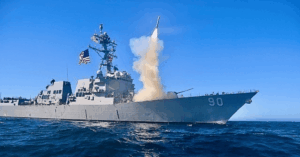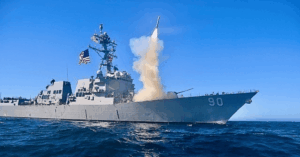
Engineer At Indian Defence Firm Arrested For Leaking Sensitive Naval Data
May 31, 2025
Tanzanian Naval Cadet Jumps Off Kochi Bridge, Goes Missing In Strong Currents
June 2, 2025

The US Navy is preparing to field a new anti-ship version of its well-known Tomahawk cruise missile on its destroyers by the end of September to strengthen its sea power as China continues to grow its naval fleet.
According to senior Navy officials, this new version of the missile, known as the Maritime Strike Tomahawk, will boost the fleet’s ability to target enemy ships. The missile, previously used for striking land targets, will now also serve a dual role, increasing its flexibility in water.
Fleet Forces Command Chief Admiral Daryl Caudle has described the missile as a “game-changer” because it increases the flexibility and lethality of the Navy’s weapons. He said that the more adaptable a weapon is, the more useful it becomes in different combat situations.
The Tomahawk has been a key part of US military operations for decades. It was first used in the 1991 Gulf War in Iraq and was more recently launched against Houthi targets in Yemen earlier this year.
The Navy plans to install the new version on its Arleigh Burke-class destroyers by September 30, 2025. It is also working to make the missile ready for submarines between April and June next year, after final testing is complete.
Chip Whipkey, the deputy program manager for Tomahawk, stated that the Navy plans to purchase as many as 1,302 Maritime Strike Tomahawk missiles from RTX Corporation.
The missile upgrade fits within the timeline of the Replicator program, a plan to deploy thousands of autonomous drones across the region to deter China. The military plans to roll out the drones in large numbers starting in August.
The Navy is also expanding its ship-attack options, including the Long-Range Anti-Ship Missile and traditional submarine-launched torpedoes. Additionally, it is also improving undersea warfare. Caudle shared that AI-powered sonar systems are currently being used on Los Angeles- and Virginia-class submarines.
These systems help submarines separate man-made noises from biological ones, such as fish or marine life, giving US submarines a better chance of detecting real threats. Navy spokesperson Commander Jason Fischer confirmed that this technology has been operational on these submarines for several years.
Meanwhile, China’s naval expansion remains a growing concern. The Pentagon estimates that China’s naval fleet, currently more than 370 ships, including submarines and aircraft carriers, could grow to 435 vessels by 2030.
This rapid growth has forced US lawmakers to invest billions of dollars into American shipbuilding in order to keep pace. However, Admiral Caudle warned against getting locked into a “shipbuilding arms race”. He explained that trying to match ship numbers one-for-one is not a sound strategy.
Instead, he said the focus should be on building high-end, capable warships with large payload capacities. He pointed to platforms like the Arleigh Burke-class destroyers, submarines, and aircraft carriers as examples of ships that offer greater firepower and combat strength than just having more vessels.
Caudle also pointed out that growing a naval fleet isn’t just about adding more ships. He said that each ship must be crewed, maintained, supplied, and housed, which adds significant logistical and financial burdens. He added, “It’s not just buying ships. You’ve got to have places to moor them and homes for their crews.”
Reference: Bloomberg
Source: Maritime Shipping News


